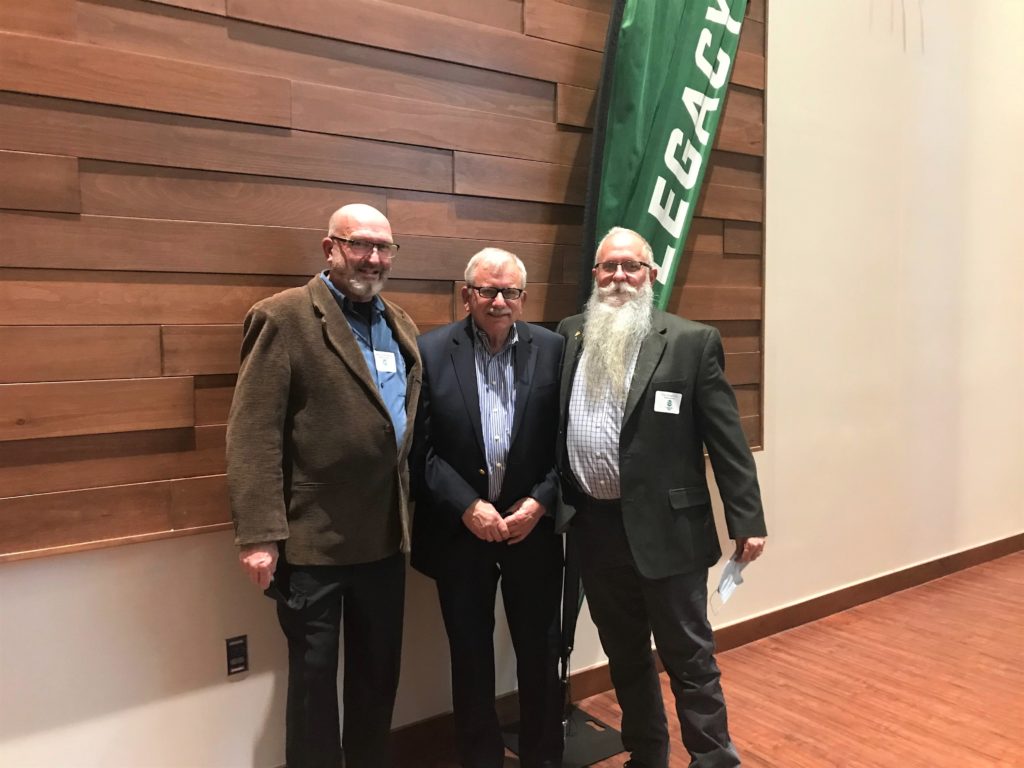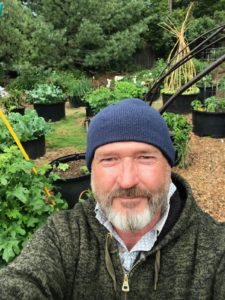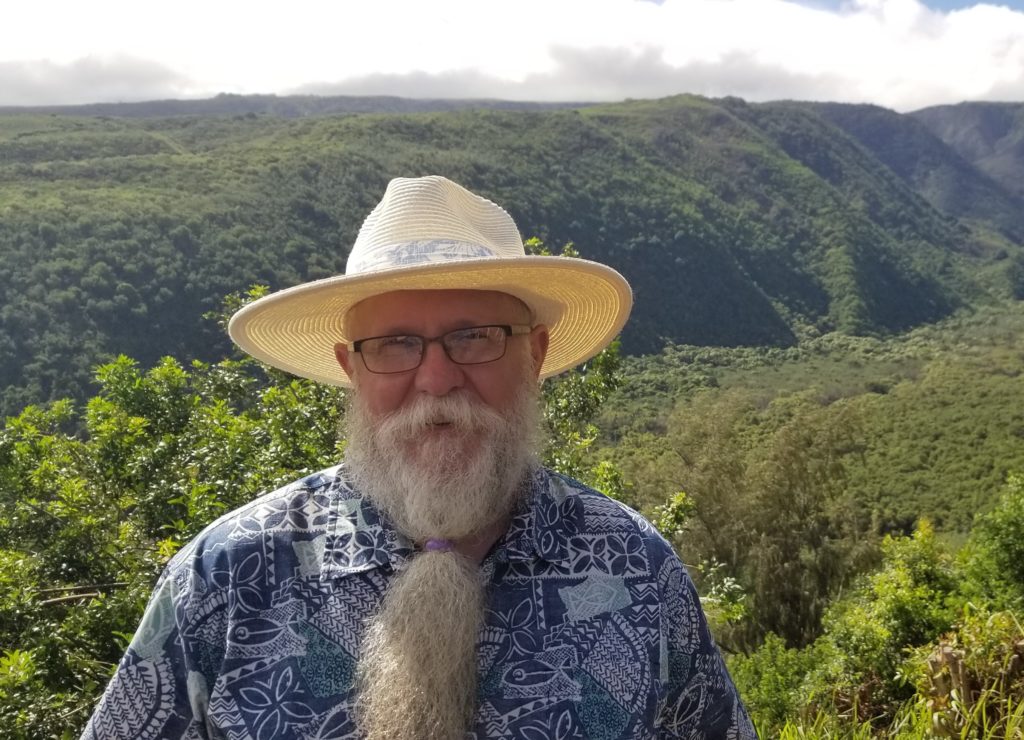
Colorado State University’s Horticulture and Landscape Architecture (HLA) Department honored two CSU alumni in February who have had distinguished careers and through their contributions and service have brought recognition to their chosen fields in the green industry.
Kelly Grummons and Ray Daugherty each received the HLA Distinguished Alumni Award. Though their career paths diverged somewhat, they share a passion for plants, learning and sharing what they learn. What they also have in common is humility. Both have a long list of accomplishments rooted in learning and sharing knowledge, not in gaining recognition. Each was simply following his passion and doing what he loves.

Kelly Grummons
At the age of six, Kelly planted his first rock garden at his home in the Black Hills of Wyoming and South Dakota. He chose to plant the unlikely combination of native prickly pear cactus and wild strawberries. When he joined 4-H at age nine, he was the sole person in the vegetable garden program, which had no leader. That didn’t stop Kelly from planting and growing. He became a methodical record keeper. “I made notes about seeds, did transplants and kept records on what I was doing,” he recalls. “When I was 13, we rented a couple of our sheep (to eat weeds) to a junk yard owner in Newcastle, WY who let me plant a garden on a half-acre that had sandy-loam soil, unlike the bentonite clay my family was accustomed to gardening on. I added lots of sheep manure, planted, and kept records of everything. It became my first entrepreneurial experience. I planted beets and cucumbers to sell.” Kelly maintained the garden throughout his high school years.
When he went to Colorado and studied at CSU—graduating in 1985—the horticulture industry was booming. Kelly studied floriculture, and greenhouse and nursery management. For two and half years of his time at CSU, Kelly exchanged care-taking duties at Plant Environmental Research Center (PERC) for free room-and-board living in an apartment in one of the few remaining Quonset huts located at PERC.
Paulino Gardens experience
“My job was in nursery management at Paulino’s and I was there for 12 years,” he says. “At the time Paulino’s grew only five perennials and over the years I developed protocols for 3,000 perennial species and varieties grown over 10 acres in 16 greenhouses. Being at Paulino’s was a great experience for me.”
From early on in his interaction with plants, Kelly was keenly observant. “People often asked how I found and developed so many new plant varieties. I just have an eye for the ‘odd balls’ and anything different or special about an individual plant, including disease resistance.” Indeed, with his propensity for detailed notetaking based on his observations, and documenting what he did to grow and propagate, he was influencing the availability of more garden-worthy plants that nature had already brought forth.
While Kelly was working at Paulino’s he met Vona Bates, who was hired on through the winter months. She was an employee at another center—Timberline Gardens—where she worked during the landscape season. Kelly and two partners would buy Timberline Gardens, thanks to Vona, in 1998 when he left Paulino’s.
Plants for Colorado
“I met Panayoti Kelaidis, [senior curator at Denver Botanic Gardens] while in college. As president of the horticulture club and the honors society in horticulture, I invited him to talk to the organizations about the state of horticulture in Colorado.” Based on Colorado’s climate and encouraged by Panayoti and Jim Klett, CSU horticulture professor and researcher, Colorado growers started to experiment, both with plants and with people’s response to them. In the early 1990s, before Plant Select® was formed, Kelly, Jim, Panayoti and numerous interested nurserymen from the Colorado Nursery Association worked to create a brochure featuring plants that grow better in Colorado.
Over the years, Kelly has developed several Colorado-hardy plants, many offered through Plant Select.
Accidental success
The story of Dog Tuff™ grass—acquired as a turf grass by Plant Select in 2015—is almost an accidental success. The grass was first spotted by Panayoti and Jim Borland in about 1990 on a property in southeast Colorado when they stopped to ask for directions. They collected a sample of what was just called Africa Grass based on where it originated.
Back in Denver, this plant wasn’t originally pursued as a turf grass. Kelly was working on designing low-water, moss-basket hanging gardens and included Africa Grass as a potential filler (like Sprengeri fern). “It choked out everything. I dumped the test baskets in my compost pile to get rid of it but it ended up covering the compost pile and spreading onto the hardpan, gravel driveway. It looked like green velvet.” Kelly came to learn that this Bermuda grass relative requires a lot less water than conventional turf grass, is resistant to dog urine—hence the name—and handles foot traffic well.
Introduced to the market in 2015, only a few years ago, Dog Tuff™ has been well-received. In 2021, it was Plant Select’s second highest selling plant according to Ross Shrigley, Plant Select executive director.
Reflecting over the years of working with plants in Colorado conditions, he says, “People need to get over an ‘aesthetic hump’ in order to appreciate the beauty of the plants that thrive in this climate.” He sees this happening as the public slowly learns not only to appreciate the aesthetic of low-water plants, but also that they are the sustainable option for water-challenged Colorado.
Full circle
Decades after his first rock garden, Kelly still loves cacti! He has been the “The Cactus Man” at Cold Hardy Cactus for the last 14 years and has developed 120 varieties from seed and cuttings. Kelly also owns DogTuffGrass.com. Furthermore, he continues to share his knowledge with the public through a Q&A column in Colorado Gardener.

Ray Daugherty
Ray Daugherty said he was “just a kid” when he attended his first green industry trade show in the early 1980s, predating ProGreen EXPO. He was a teenager and attended with the owners of Arborland Nursery, a tree farm.
Within a couple of years, Ray went off to CSU to study horticulture. It’s interesting to note that both Kelly Grummons and Ray were recipients of the Distinguished Alumni award this year, and Ray says, “Kelly Grummons was the first person I met at CSU.”
During Ray’s first two years, he cared for plants at PERC (Plant Environmental Research Center) while staying free-of-charge in one of the remaining Quonset huts left over from the 1940s. This was a ‘perk’ of a different kind for Ray, since he was financially responsible for his college education.
“I was more into trees than greenhouses, before coming to CSU. I came to appreciate greenhouses after those two years of caretaking.” Ray also worked for Jim Klett in the arboretum and had an internship at Denver Botanic Gardens (DBG). After graduating from CSU in 1988, he worked at Green Acres Nursery for several years and for a short time at Center Greenhouse as a propagator.
From business owner to educator
Ray started his own company in the mid-1990s. During this time, Ray was doing some parttime teaching at DBG. “Then I had what felt like was a ‘happy accident.’ Jim O’Shea, who started the horticulture program at Front Range Community College (FRCC), was retiring. He called me and asked me to apply for the faculty position. I got the position and left my business.”
“Getting this position was an amazing opportunity for me. I could take all that I’d learned from my mentors (Dr. Klett and the nursery and greenhouse professionals I’d worked with) and structure it to teach others. I wanted to make it more understandable and applicable so others could succeed in the industry,” he shares. “It has been great fun!”
During his 23 years at FRCC, Ray received awards, contributed to industry resources, served on numerous industry committees and more. Notably, he overhauled the associate of science degree (AAS) at FRCC and helped develop the Colorado Community College System’s transfer degree agreements with CSU.
It’s all family
“What I like about the horticulture and nursery trade is that, though competitors, people are willing to teach and share to help everyone move forward. It’s like a big family and a pleasure to be part of,” Ray acknowledges. “It’s not just that I love horticulture, but I love the people in it!” Something that felt especially endearing to Ray about the awards event was that Kelly, Jim Klett and he were there in the beginning at CSU and were now together again decades later for the award. And just as important, one of Ray’s students from FRCC was also receiving an award. “I never felt like I was doing anything special, but to see one of my students there made me realize I made more of an impact than I thought,” he confesses.










